Table of Contents
The origins of Czech nymphing can be traced back to Poland, anglers were forced to fish at short range using a nylon line because they didn’t have access to fly lines.
The Czech competitive anglers developed this short-line nymphing technique and went on to win their 1st Gold medal in the 1986 World Championship.
Why learn the Czech nymphing?
The answer for Me is simple, it’s a…
deadly method for catching grayling & trout on rivers.
In essence, it involves fishing nymphs close to the riverbed where the fish’s food source, aquatic insects, spend 99% of their life.
You only have to pick out and examine a few submerged stones or patches of weed to see the abundance of food crawling over them; e.g. nymphs, shrimps, caddis larvae etc. All of these are vital parts of a fish’s diet.
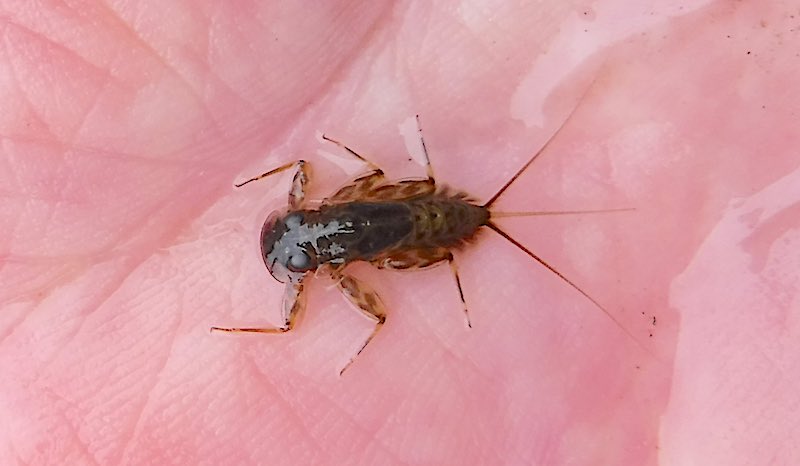
That is why, when practised Czech nymphing becomes…
a reliably successful fishing method.
However, when nymphs leave their underwater homes to complete their lifecycle the tables turn and for a brief moment…
classic dry fishing and wet fly steal the show
The Czech / Euro nymphing technique is now considered by modern anglers to be a standard fly fishing method that will provide plenty of great fishing memories.
So, what is required to start Czech nymphing…
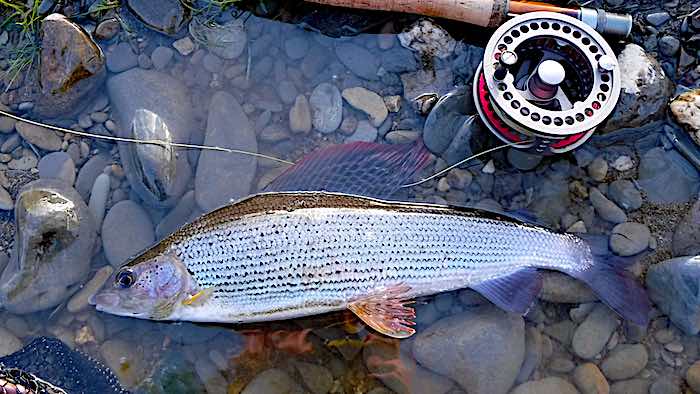
Fishing tackle for Czech Nymphing
Nymphing rod
There is no need for a specialist Czech nymphing rod to start nymphing. A standard 9 to 10ft fly rod that is rated from #3 to #6 weight will work just fine for most rivers and streams. I started my journey with a medium-action 10ft 6# rod.
Once you progress to doing a lot of nymphing then investing in a soft-medium action rod (10ft, #3 weight) is beneficial for several reasons:
- Drift length will be as long as your reach and a longer fly rod extends your reach and hence cover more water effectively.
- Lightweight soft-tip fly rods are designed to detect takes and flex to protect light tippets when you strike to set the hook.
- A long soft-tip fly rod makes it easier to play fish at close range because it will absorb the shock when a fish dashes for freedom.
In addition, select a rod as light as possible within your budget because this will minimise arm aches.
The rod I’ve been using for a few years is an Airfo Stream Tec Nano (10ft #3/4), which I bought for about £100.
If you want a specialist Czech / Euro nymphing rod you will be looking at the £300 and upwards price bracket. I recently upgraded to an 11ft #3 Vision Nymphmaniac rod, which is a dream to fish with and it was worth every penny.
Fishing Reel for nymphing
You can start Czech nymphing with a standard fly reel that is matched to the weight of the rod. Unlike traditional fly fishing methods, you rarely have any line off the reel. Therefore, select a reel that has a sensitive and smooth drag system, which is easy to adjust.
There is an advantage to having a cage spool reel which prevents the leader line from jamming behind the spool. Currently, I use a 4/5 Vision XLV nymph fly reel.
Nymphing Fly line
As with the rod and reel, you can start Czech nymphing using a standard floating fly line matched to the rod. This is how I started several years back.
Now, however, I use an Airflo SNF Euro Nymph line, low diameter (0.6mm), fly line because it is much easier to control in windy conditions.
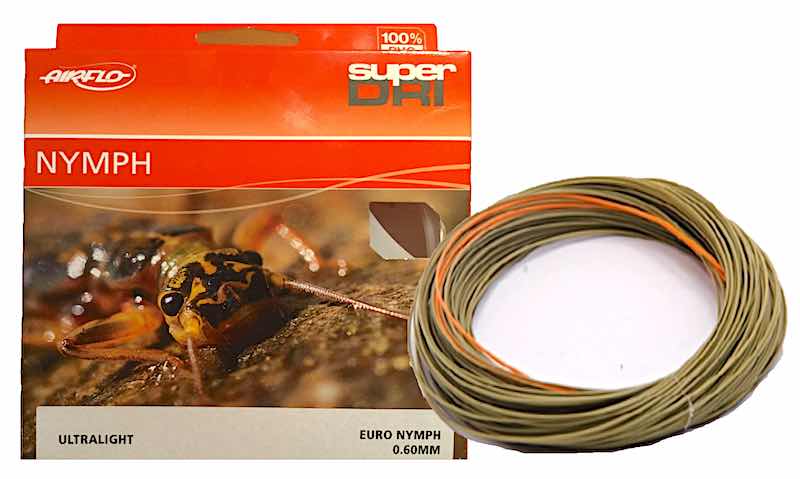
When to use Czech Nymphing?
Czech Nymphing is a fly fishing technique that can be used to catch trout and grayling throughout the seasons. However, I’m much more selective because I also enjoy fishing dry and wet flies.
Consequently, irrespective of the time of year you will find me nymphing when…
- there is no evidence of trout and/or grayling taking flies in or on the surface,
- the river is high and/or coloured
- when it’s difficult to fish the fly with the other methods.
In autumn, winter and spring I often begin the day fishing Czech nymphs until I see fish taking flies at the surface. At this point, I will switch to either wet or dry fly fishing.
Where to fish Czech nymphs?
On many UK rivers (e.g. Welsh Dee, River Ribble, River Calder, etc.), short-line nymphing techniques are indispensable because they will bring you a lot of unforgettable experiences.
Czech nymphing is best employed where there is enough flow to get the nymphs to tumble along the riverbed. For example,
- riffles, fast runs, deep glides;
- boundary lines (seams) between fast & slow currents and back eddies;
- alongside and behind obstacles (e.g. boulders, weed bed, submerged logs, etc.);
- through depressions in the riverbed.
I use this technique when the river is either too deep, quick or both for traditional upstream nymphing to get the flies down into the feeding zone.
On the Welsh Dee at Llangollen, a few good places to practice Czech nymphing include:
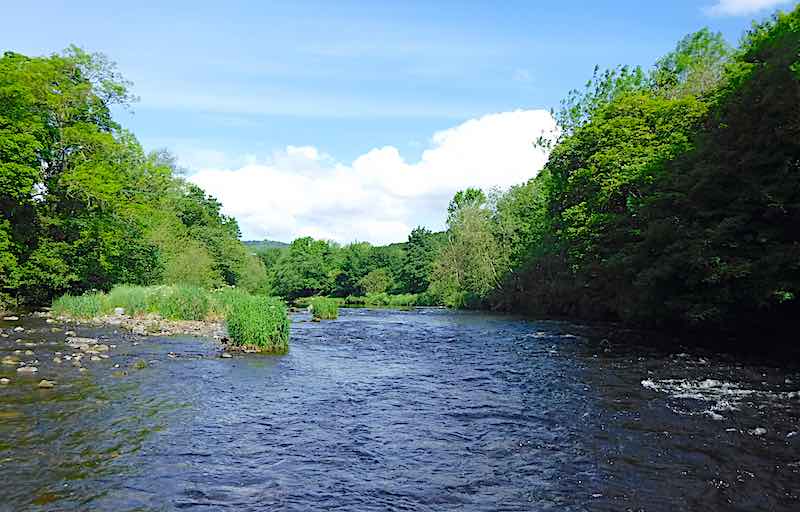
How to fish Czech Nymphs?
Czech nymphing (Euro or short-line nymphing) is a method of fishing a team of 2 or 3 weighted nymphs on a fine leader at short distances from the rod tip (also referred to as short-line nymphing and/or Euro nymphing).
The technique was developed to catch grayling and trout that were feeding on bottom-dwelling insects in fast-flowing streams and rivers.
It doesn’t compete with the excitement of catching fish on the dry fly but when you become proficient, it will help you avoid blank days and maybe catch a fish of a lifetime.
Czech Nymphing leader set-up:
It’s important when learning how to Czech nymph that you begin with a simple 2 or 3-nymph leader setup that includes an indicator to detect bites. My standard leader setup is made up of…
- 10m Daiwa tapered carp leader 30lbs to 12lbs
- RIO Two-Tone Indicator Tippet (2X)
- 3 – 5ft 4lb fluorocarbon tippet (Airflo Sightfree G3)
- Two 4” droppers spaced 18” apart (4 lb Fluorocarbon)
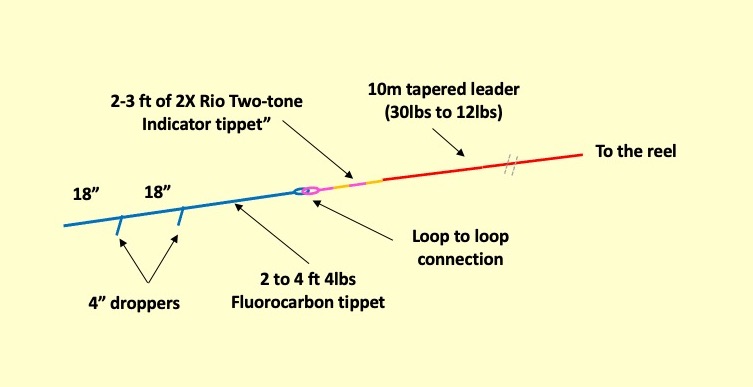
Indicator choice is personal because you need to select one that you can easily see. Currently, I use the 2X RIO Two-Tone Indicator, but I started using an indicator made from two different coloured 12lb lines joined together.
A Google search on Euro / Czech nymphing indicators will reveal many commercial alternatives.
Whether you start with a 2 or 3-fly setup it’s important to put the heaviest nymph should go on the point of the leader and the lightest nymph on the top dropper. The point fly should have sufficient weight to enable it to bounce along the riverbed in the current, but not too heavy that it constantly snags the riverbed.
The following video covers making a three-fly Euro Nymphing rig for trout and grayling fishing in high water.
The above arrangement aids bite detection because it will maintain a ‘tight’ line when leading the nymphs downriver.
In addition, it will minimise tangles and I believe lighter nymphs fished higher in the water column are more mobile, mimicking the motion of natural insects.
Czech Nymphing technique
The technique involves casting the nymphing rig upstream, allowing it to sink to the bottom with your fly rod held with an outstretched arm. Then follow their passage downstream with the tip of the rod, ensuring you keep in contact with the flies all the time.
Takes show up as a change in the motion of the leader, which could be:
- a slight stop in the steady downstream movement,
- sideways movement of the line,
- or a rapid deviation in line movement.
Any of the aforementioned should be met with a downstream strike, parallel with the surface of the river.
It is important to keep in contact with the flies by mimicking their movement through the water with the rod tip, otherwise, your ability to observe a take is significantly impaired.
Don’t be too hasty to recast at the end of the drift because when the line tightens the nymphs lift off the bottom and this can induce a fish to take. Therefore, wait a few seconds before recasting to cover a slightly different area of the riverbed.
Czech / Euro Nymph Selection
At the business end of the leader, there’s a multitude of fly patterns that can be used.
Czech nymph patterns were designed to imitate caddis larvae and freshwater shrimps. Traditionally, tied on curved Gammarus hooks (size 8 to 16) and weighted with lead wire.
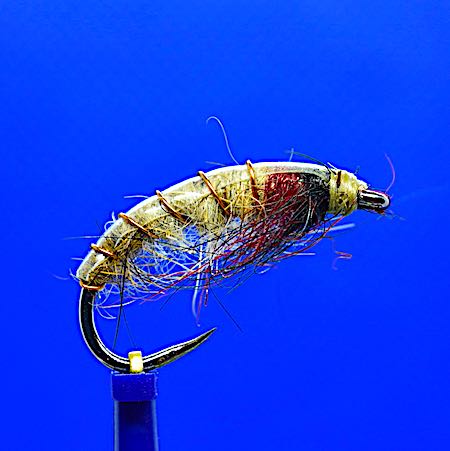
The body is formed using natural or synthetic dubbing with a shellback formed using latex foil or similar plastic sheet material. Monofilament line or coloured wire ribbing is added to form a segmented body and protect the shell back.
It’s important to have thinly tied Czech nymphs because this helps them sink quickly to the riverbed.
Purists will point out that Czech nymph-style flies should be used with the method. However, you can use other types of weighted nymphs, e.g. beaded nymphs, traditional nymphs (e.g. pheasant tail, hare´s ear, etc.) or nymphs tied on special hooks (e.g. jig-hooks).
Jig-hook nymphs are great fished on the point because the hook rides upwards and is less prone to snagging on the bottom.
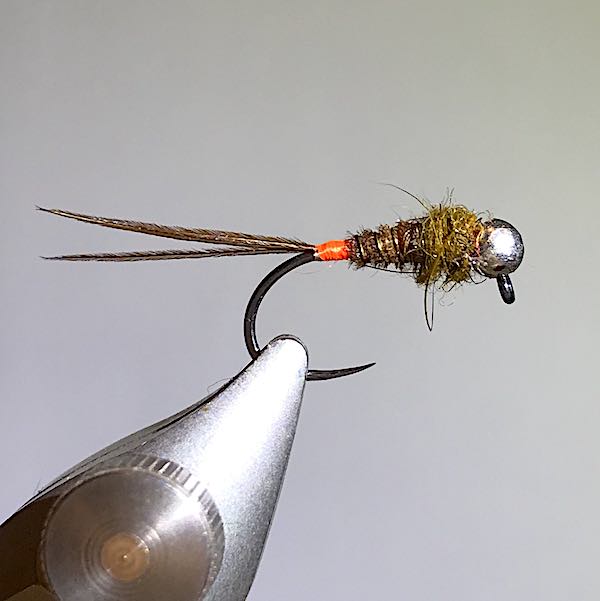
In the situation where you’ve no idea what pattern works on a particular river then start by using three patterns with distinctly different colours. Often I tie a natural pattern on the top dropper and a more colourful pattern on the other dropper and point. For example…
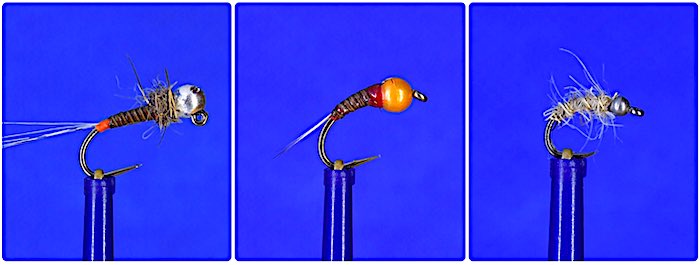
Typically, I will fish my initial selection for about 20 minutes to give them a fair chance. If they haven’t worked, I start testing alternatives until success comes.
Once I’ve identified a successful pattern, I will switch the other two nymphs over to a similar pattern but in different sizes.
How do river conditions affect nymph selection?
For me, the primary variable to consider when selecting which nymphs to use is…
‘Water Clarity’
Secondary variables include…
- river ecology (an insect life present),
- time of year (water temperature).
Building knowledge of the above comes from practical experience. However, to help newcomers to Czech nymphing, I’ve described 16 nymphs that catch grayling and brown trout.
Nymphs for fishing ‘coloured water’
The simple definition ‘coloured water’ I use is when the riverbed is just visible at a depth of 3ft to 1ft. [N.B. If clarity is < 1ft it’s probably best to go to the PUB or focus on Czech nymphing in very shallow water]
Point nymph selection:
For fast deep coloured water, a bright heavily weighted point fly is needed to take the other flies down to the fishing zone.
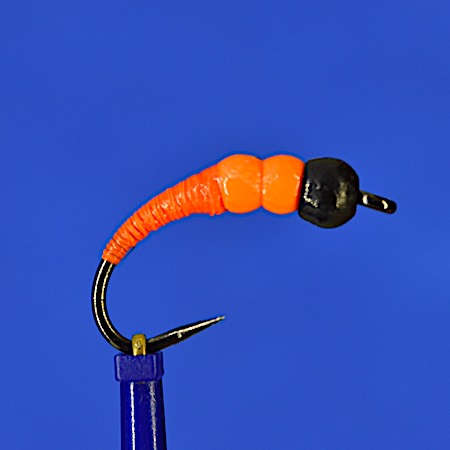
Orange BOMB
- Hook: Partridge CZ size 10
- Beads: 4.5mm TB & 2×3.5 orange
- Thread: Orange UNI 6/0
It’s useful to have this pattern tied in various bright colours e.g. pink, red, orange etc.
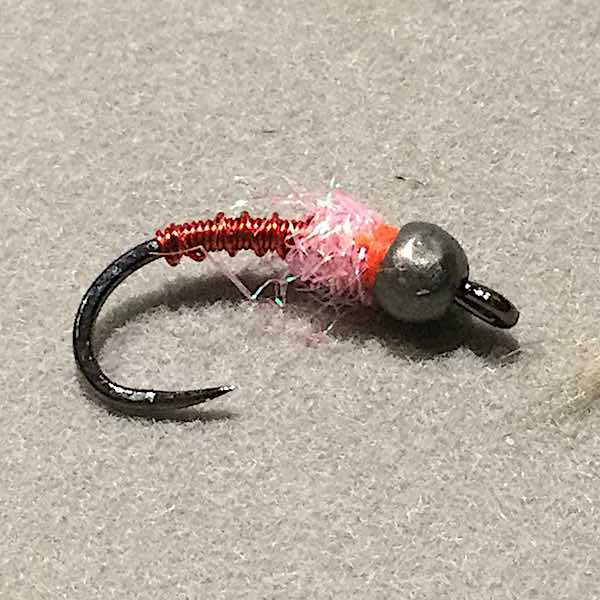
Pink Collar Brassie
- Hook: Partridge CZ size 10 & 12
- Bead: 4 to 4.5mm
- Thread: Orange UNI 6/0
- Body: medium red wire
- Thorax: pink sparkle dubbing
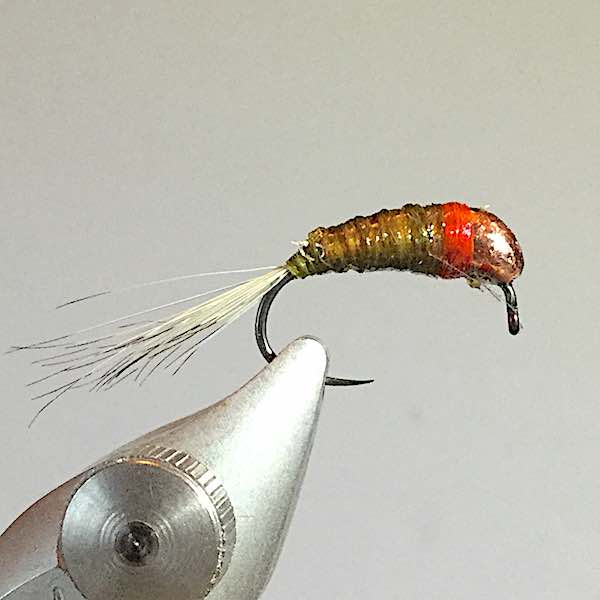
Olive Tungsten Jig-back
- Hook: Hends BL154 (#12)
- Tail: badger cock hackle fibres
- Body: copper XL-tungsten jig-back
- Thread: Olive UNI-Thread 8/0
- Collar – orange UNI-Thread 8/0
- Coating: UV – Varnish:
Middle dropper nymph selection:

Peacock cased Caddis
- Hook: Hends BL154 (#14 &12)
- 3.5mm gold tungsten bead
- Thread: Olive UNI-Thread 8/0
- Tail: orange floss
- Body: Peacock herl
- Rib: Fine red wire
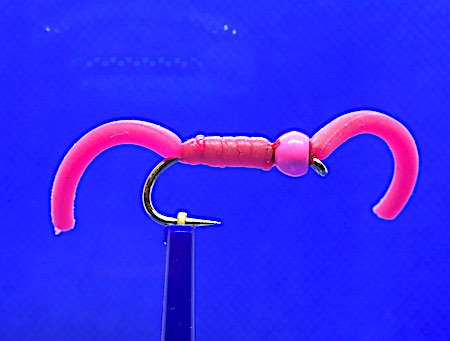
- Hook: Kamasan (#14 &12)
- 3.5mm pink tungsten bead
- Thread: read UNI-Thread 8/0
- Body: pink squirmy worm
Squirmy worms are not everyone’s cup of tea. However, it’s worth having a fly box with some in it because sometimes they’re the only thing that will catch grayling and trout when the river is running off after a flood.
I always carry a few squirmy worm variations tied with different coloured beads and squirmy material. For me, they seem to work best on the middle dropper.
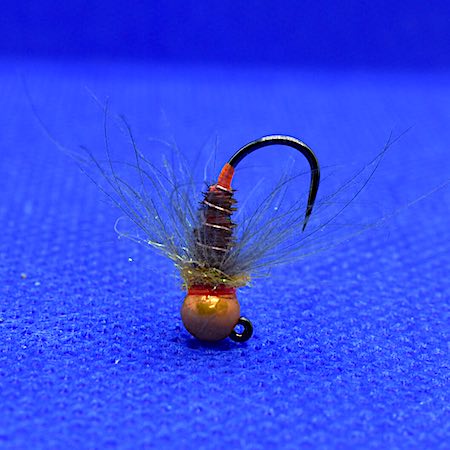
Orange bead PTN
- Hook: Hends BL154 (#12 & 14)
- Bead: 3 or 3.5mm orange tungsten
- Thread: orange UNI-Thread 8/0
- Tag: orange UNI-Thread 8/0
- Body: pheasant tail fibre
- Rib: fine copper wire
- Hackle: CDC feather
- Collar: sparkle brown dubbing
Top dropper nymph selection
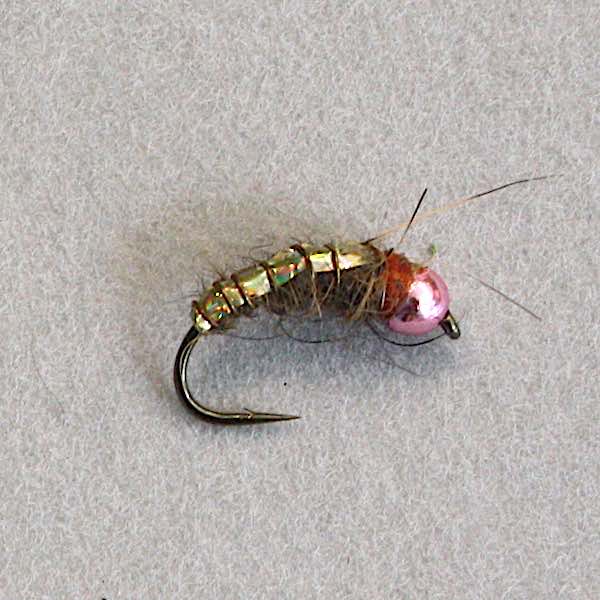
Hare’s Ear – gold shellback
- Kamasan KB110 (size 14)
- 2.5mm pink or gold tungsten
- Brown UNI-thread 8/0
- Body – Hare’s ear dubbing
- Rib – fine gold wire
- Back – flat gold tinsel (2mm)
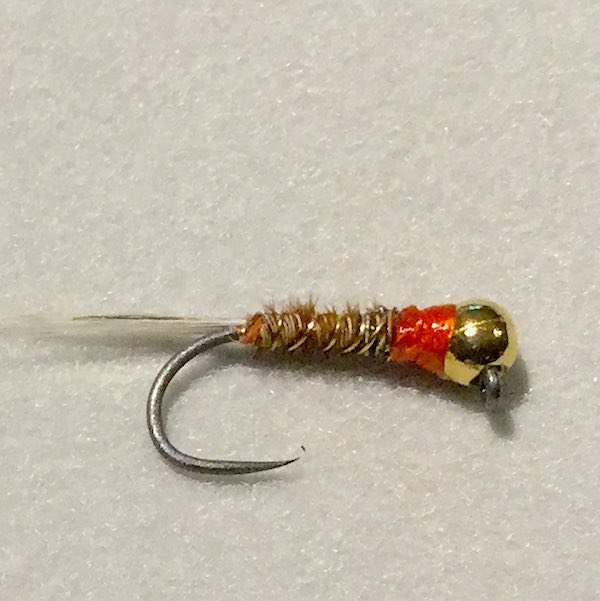
TB Pheasant Tail Nymph
- HENDS BL154 (#14)
- 2.5mm gold tungsten bead
- Orange UNI-thread 8/0
- Tail – 3 pheasant tail fibres
- Body – 3 pheasant tail fibres
- Rib – fine copper wire
- Collar – orange Uni-thread 8/0
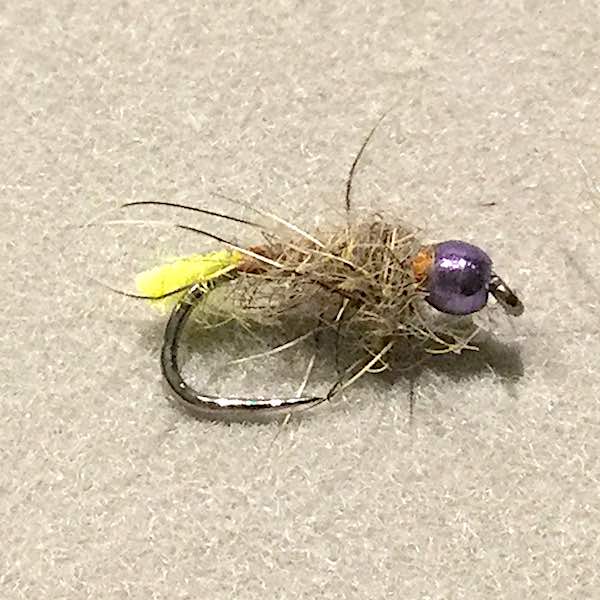
Hare’s Ear yellow tag nymph
- HENDS BL154 (#14)
- 2.5mm purple tungsten bead
- Orange UNI-thread 8/0
- Tail – yellow floss
- Body – Hare’s Ear dubbing
- Rib – fine copper wire
It is also worth having a few variations with bright-coloured beads (e.g. gold, silver, pink) and alternatives with an orange or red tag.
Nymphs for Czech nymphing in ‘clear water’
The simple definition of clear water I use is that the riverbed is visible to a depth of greater than 3ft. Often in this situation, it is best to fish nymphs that more closely resemble natural insects.
Point nymph selection (clear water):
When the water I’m fishing is less than 3ft deep then I often use either of the following two nymphs.

Light Olive Czech Nymph
- Hook: Partridge CZ #12
- Thread: Olive UNI 6/0
- Body: Light olive dubbing
- Thorax: Claret and black dubbing
- Shell: Clear nymph skin
- Rib: Medium copper wire
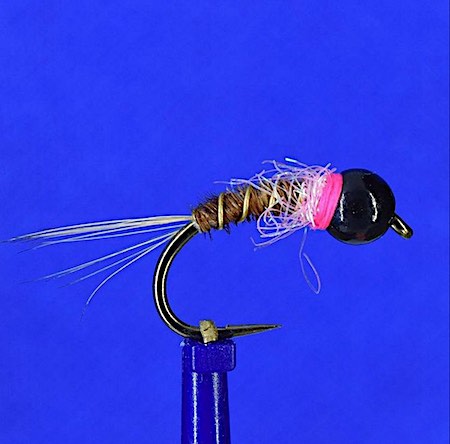
Pink Collar PTN nymph
- Hook: Kamasan B100 (#12 & 14)
- Bead: 3 or 3.5mm tungsten
- Thread: pink UNI-Thread 8/0
- Tail: olive cock hackle fibres
- Body: pheasant tail fibre
- Rib: fine copper wire
- Collar: pink sparkle dubbing
When I need to get small nymphs to the riverbed quickly in deep clear water I resort to tying the following fly on the point.
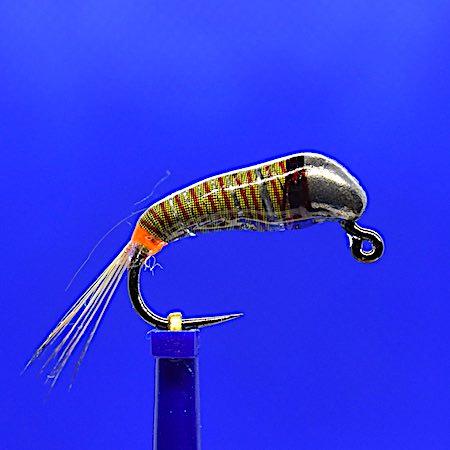
Olive Tungsten Jig-Back
- Hook: Hends BL154 (#12)
- Thread: Brown UNI-Thread 8/0
- Weight: XL-tungsten jig-back
- Tail: badger cock hackle fibres
- Tag: orange floss
- Body: Synthetic olive quill
- Coating: UV resin
Middle & top dropper nymphs (clear water)
The following four Czech nymphs are the ones that I often use and have caught plenty of trout and grayling when the river is running clear. In the middle of the summer, it is best to fish the patterns tied on small hooks.
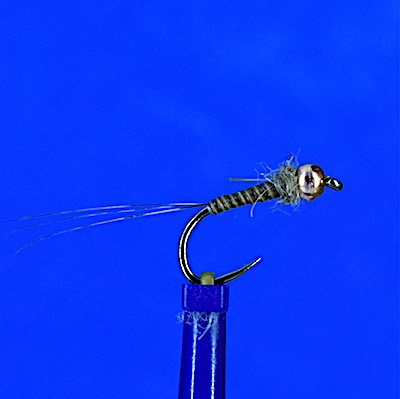
TB Quill nymph
- Hook: HENDS BL345 #16 & 18
- Bead: 2mm silver tungsten
- Thread: 12/0 white nano silk
- Tail: Coq De Leon fibres
- Body: Peacock quill
- Thorax: Hare’s ear dubbing
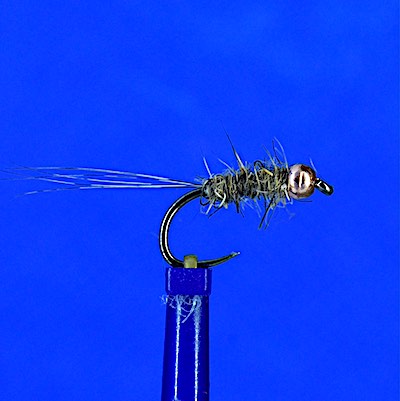
Hares’s Ear nymph
- Hook: HENDS BL345 # 16
- Bead: 2mm copper tungsten
- Thread: Brown UNI-8/0
- Tail: Coq De Leon fibres
- Body: Hare’s ear dubbing
- Rib: Fine gold wire
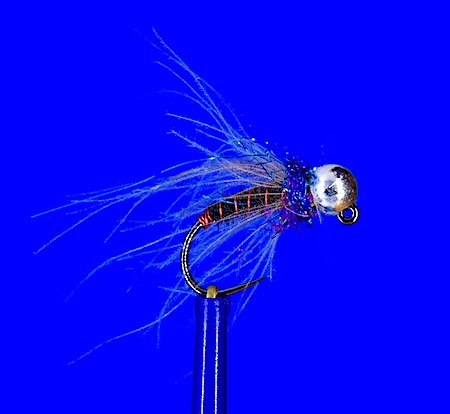
Purple collar black nymph
- Hook: HENDS BL345 #16 & 18
- Bead: 2 or 1.5mm silver tungsten
- Thread: Black UNI -8/0
- Body: Black PTN
- Rib: Fine red wire
- Hackle: CDC feather
- Collar: Purple glister dubbing
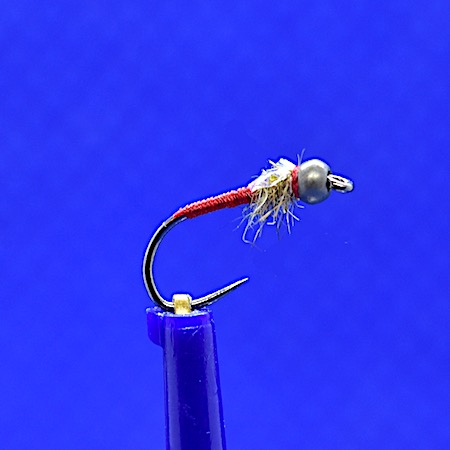
Red nymph
- Hook: HENDS BL345 #16 & 18
- Bead: 1.5mm purple
- Thread: Red UNI 8/0
- Body: Red UNI 8/0
- Thorax: Hares Ear dubbing
- Wing case: Pearl Mylar 1/8”
It is also worth having the versions of the above nymph tied using various coloured tungsten beads (e.g. neutral, black, silver, copper, gold).
I hope you have found this post interesting and that it has provided the nymphing essentials to get you started. If you have any questions, please raise them in the comment section.
Finally, there’s some excellent day ticket water on the Welsh Dee, which is great for practising the Czech nymphing technique.
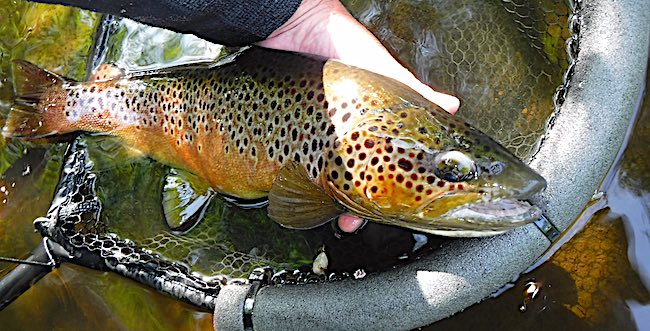
In 2013 I had a days fishing with a Guide on the River Tweed where I was shown how to Czech Nymph. Had a great time but never fished this style again. The information provided is just what I needed, as now being retired, I can now continue to fish all year round (once we are free to do so.
I’m glad you found the post useful and I hope you catch plenty of grayling using some of the flies mentioned. Cheers, Andrew
,very informative. And interesting article thanks
Hi Ted,
Thanks for letting me know you found the article interesting. It helps me develop this fishing blog.
Cheers, Andrew
Hi Andrew , another good informative piece, going to keep me busy at the tying vice till lock down is over , can’t wait to get to LLangollen to fish the Dee
Hi Alan,
This lockdown is dragging on and it doesn’t look like we will be allowed back into Wales in the near future. Therefore,I’m spending a lot more time on the website to keep myself amused and it’s great to hear that the blogs are keeping you occupied at the vice.
Cheers, Andrew
Thank you for such an informative article. May I ask a question about proximity to the fish?
I fish some very narrow becks in Yorkshire – typically they are 20ft wide. So I am able to stand near one bank and fish the other side using the Czech style. But – is this too close to the fish? Will I spook the Grayling? Would I be better off casting a nymph upstream to them?
Hi Paul,
It’s always wise to try and avoid spooking the fish. For small streams, it is better to cast upstream.
I hope this helps, Andrew
Another informative post. Thanks.
Thanks
Great article thanks.
Hi David,
Great to hear you enjoyed it.
Thanks for the feedback, Andrew
Hi there, a great easy to understand article, thanks. itching to give this method a try now that our club has recently got beats on a couple of local rivers with grayling
Hi Ian,
Glad to hear you found the article interesting. Would be great to know how you get on grayling fishing on your local rivers.
Cheers, Andrew
Excellent and informative as ever, many thanks.
Hi Andrew,
Thanks ever so much for another truly informative and easily understood article (not over complicated or self indulgent like some authors!)
I have yet to fail to find your blogs anything but educational and a pleasure to read!
Tight lines 🙂 keep up the good work
Steve Holden
Hi Steve,
It’s great to know that you are enjoying them. Thanks for the great feedback.
Tight lines, Andrew
Good stuff – thank you. Have you a preference between Euronymphing with a thin fly line or using a thin mono leader(0.25 or 0.18 mm diameter)?
I’ve used both methods but now use a 5m tapered shock leader attached to the end of dry fly line https://www.fishingmegastore.com/shockleaders-and-tapered-leaders/tronixpro-xenon-tapered-shock-leader-leaders-5x15m~22590.html?&utm_medium=shopping&utm_campaign=SHP_GR20&housecode=TX6344
I always find your blogs useful. Thanks for continuing to post.
Hi Ron,
Great to hear you are enjoying them.
Tight lines, Andrew
Hi Andrew, a really good article as usual with lots of patterns for the tyer to try and well presented information on how to fish these nymph patterns. I am up on the River Tees in early May and expect to be using the Czeck nymphs quite a bit especially if it is cool.Tight lines, Iain.
Hi Iain,
I hope you have some great sport on the Tees.
Tight lines, Andrew
Hi Andrew. I’m interested to know what would make you choose to fish Czech nymph in preference to fishing a team of 2 or 3 wet flies (nymphs, spiders, traditional wets etc). Great informative article as usual!
Hi David,
When I see fish rising or flies hatching I normally fish with wet flies or dry flies first. Then I might fish the pool again with nymphs. If nothing is hatching then I will focus on nymphing. During a days fishing I might switch between the methods until I find out what is working best.
I hope this helps, Andrew
Many thanks Andrew !
I hope you enjoy it.
Excellent article as usual Andrew, extremely informative. Many good techniques to digest and great fly choices.
Hopefully be out on the Dee Sunday for Salmon, but will have the trout rods if conditions are suitable. Tight lines and all the very best. Scott
Hi Scott,
Great to hear you enjoyed the article. It’s a bit early for salmon fishing on the Welsh Dee but good luck.
Tight lines, Andrew
Andrew. Question about your specialised nymph line that you reference in the article. Do you use it in conjunction with the 10m carp leader you also refer to in the article with droppers attached via tippet to the leader. If that’s the case, then surely the nymph line is only really used as backing on the reel most of the time as I assume you are only casting 1-2 rod lengths (20-25ft) when Czech nymphing. I’m just trying to understand whether it’s worth investing in the specialised nymph line. Thank you for your articles. So valuable for a novice like me!
Hi David,
You don’t need to invest in a specialist Nymphing line. You can just add the carp leader to the end of a standard floating fly line.
I hope this helps, Andrew
Morning Andrew, another excellent in depth article. Thoroughly enjoyed. Cheers
Hi Scott,
Great to hear you enjoyed it.
Tight lines, Andrew
A great ‘refresher’ on a technique I use only infrequently tbh, though it is very effective once you have got the hang of it and found the fish.
Hi Charles,
It does take a bit of practice, but can be deadly.
Andrew